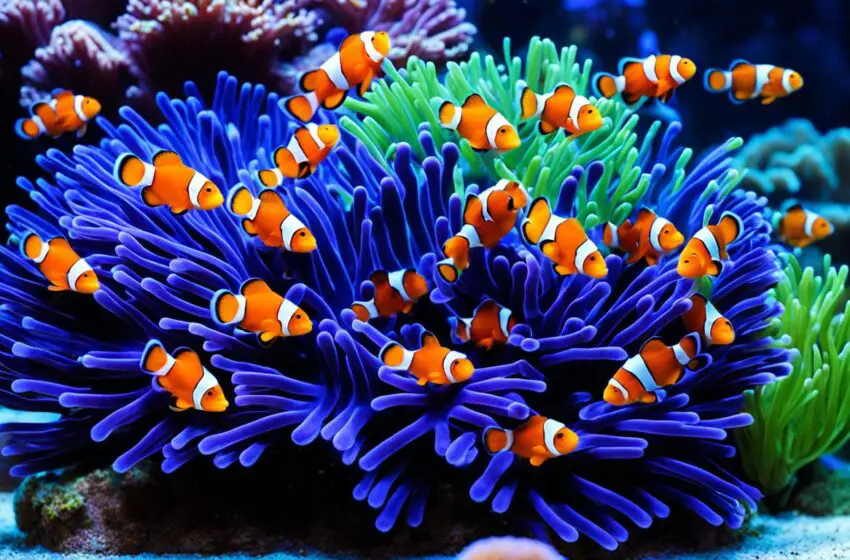Pairing Clownfish: Building Bonds in Your Tank

Pairing clownfish can bring joy to aquarium lovers. These fish are lively and known for their bright colors. Despite their reputation as territorial, they form strong bonds under the right conditions. Let’s dive into how to pair them successfully in your tank.
Key Takeaways:
- Pairing clownfish can be a rewarding experience for aquarium enthusiasts.
- Clownfish can easily pair up if one is larger than the other and they are acclimated in the same tank.
- It is recommended to have a tank with only clownfish to avoid disruptions in the pairing process.
- There are different methods to choose clownfish for breeding, including pairing juveniles, a smaller male with a larger female, or starting with a bonded pair.
- Size and compatibility are crucial considerations when selecting clownfish for breeding.
Choosing Clownfish for Breeding
When selecting clownfish for breeding, you have many choices. Each one has its own pros and cons. This helps you pick what’s right for your breeding goals and budget.
Option 1: Juvenile Clownfish Pairing
Pairing two juvenile clownfish is one choice. The bigger one often becomes the dominant female. The smaller becomes the male. This method is cheaper. But, the female may need years to lay eggs.
Option 2: Pairing a Smaller Male with a Larger Female
You could pair a smaller male with a bigger, older female. It costs more than matching juveniles. The success depends on if the female likes the male. Watching them closely is key.
Option 3: Starting with a Bonded Pair
Starting with a bonded pair of clownfish is another way. A bonded pair sleeps and stays together. This route offers better chances of breeding success.
But, make sure they truly get along. Observing them will tell you if they are a good match.
Option 4: Purchasing a Breeding Pair of Clownfish
Buying a breeding pair is a surefire method. These fish are mature and have bred before. Yet, this is the costliest option. And, they might not lay eggs in a new tank right away.
Think about your goals and budget for choosing clownfish for breeding. There are different paths, be it with juveniles, a new pairing, a bonded duo, or a ready breeding pair. The right care and good breeding conditions can boost your success in raising clownfish.
Pairing Up Clownfish
Choosing the right clownfish pair is crucial for breeding success. First, make sure they’re a good match. Then, it’s time to start their bonding process. If the clownfish are young, put them in the tank together. But, they should have a size difference. This sets up who’s in charge and stops fights.
If the male is small and the female is big, start by separating them in a breeder net. This way, they can get to know each other without getting hurt. After they’re used to one another, let the female join the male in his tank. Watch how they get along closely.
Getting clownfish to bond can be a slow process. It might take a few days or even weeks. If they don’t bond, you might need to try again with a different pair. You should keep an eye on them to avoid any fights or injuries.
Taking care of your clownfish’s environment is key. Ensure the tank has proper lighting and stays at the right temperature. Also, feed them food that will help them stay healthy and ready to reproduce. Creating the best home for your clownfish increases the chance of them breeding successfully.
FAQ
Can I pair clownfish with other fish in the same tank?
It’s best to keep a tank with only clownfish. This is because other fish can mess up their pairings.
What are the different methods to choose clownfish for breeding?
Several methods work for selecting clownfish for breeding. This includes introducing two young clownfish or using a smaller male with a bigger female. You can also begin with a pair that’s already bonded.
Is there any guarantee that the clownfish will breed after being moved?
Buying a known breeding pair is a good start. This means they are mature and have reproduced before. However, no one can promise that they will lay more eggs after a move.
How should I pair up clownfish?
If your clownfish are young, just adding them to the same tank is often enough. For a smaller male and larger female, start by keeping them apart in a net. This lets them see each other but prevents fighting.
What is the bonding process for clownfish?
The bonding period for clownfish can last from a few days to several weeks. Sometimes, they might not bond at first, and you might have to try again.
How do I condition clownfish to breed?
To get clownfish ready for breeding, set up the tank right. Make sure the lighting and temperature are perfect. A good diet is also crucial for their health and reproductive success.



